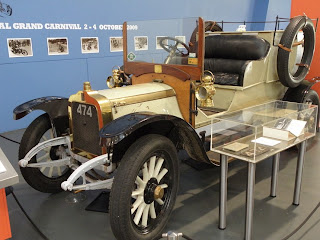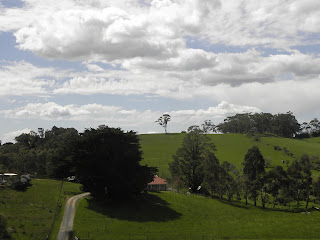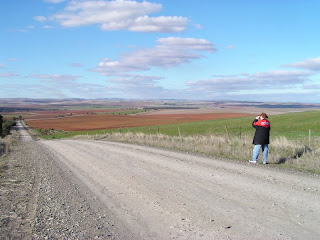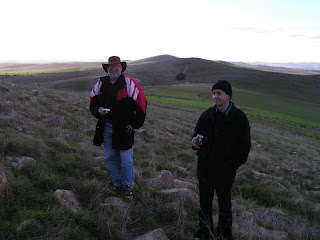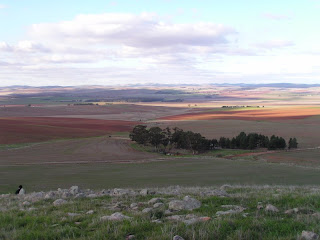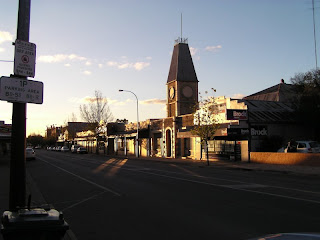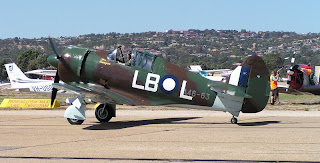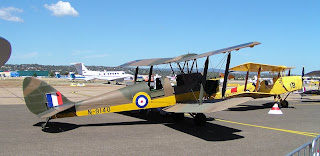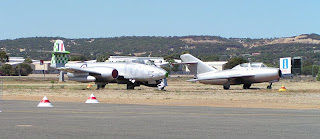My first ever visits to Canberra with my dad were in winter, and I always thought of it as like Antarctica. I have to say, it's no fun in the peak of summer either. But it's still one of my favourite places. This trip was winter. I'm not a hot weather person.
The family pics (apart from a couple for my non-Facebook friends) are in my FB albums. So apart from a few samples, this is the boy-toy part of the trip. The one for mainly history geeks.
Well, for starters, Canberra has a Telstra Tower. That's no big deal. Every city has one, or wants one because the neighbours all have them. But I wanted to try out the zoom on my new camera (an Olympus SP590UZ, if it matters to anyone). I took the shots at max resolution, some of them up to 5mb big and much larger than I need for postcard prints, so I better find out how to fix that.

Here's
Lake Gininderra, an artificial lake adjacent to the major shopping centre at Belconnen.

OK, onto the history geek stuff. I had a quick look around the
Australian War Memorial to catch up on changes. Here's the shot everyone takes of the main building.

Mostly I just wanted to have lunch with the family ;) and look at the new aircraft exhibits, but for anyone interested we'll do a little ANZAC stuff. And here we are at the very beginning of the ANZAC tradition - Gallipoli, defended by soldiers in uniforms like this;-

The men from Britain and the Dominions came ashore to invade Turkey itself. They could hardly have expected the Turks to take that lying down, and they didn't. It was a bloodbath, and the Empire didn't get very far at all.
Like the song (by Eric Bogle, a Scot living in Oz) says, "Johnny Turk, he was waiting. He'd primed himself well ... and in five minutes flat he'd blown us all to hell, nearly blew us clean back to Australia". (See and hear it
on YouTube. It's one of my favourite modern Aussie folk songs. My dad hated "Waltzing Matilda", it was played during the war everywhere Aussies went overseas, on the assumption a song about a failed and suicidal sheep thief was our national anthem.)
The great ANZAC legend has its smaller legends. One is about an Irish trade unionist (back then, it was the same as "Bolshevik") who deserted his ship in Australia, changed his name from Kirkpatrick to
Simpson and went ashore at Gallipoli. He went unarmed. For three weeks, he brought back wounded soldiers on the back of a donkey, until a Turkish machine gunner got him. Those three weeks and 300 rescued men made him a true-blue, dinky-di icon. And earned him a statue outside the War Memorial. Wonder what he'd have said? "Aw, Jesus, mate!", possibly.
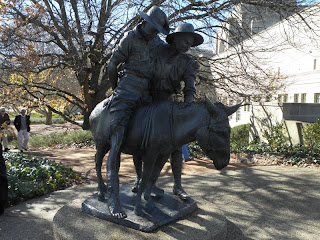
When it was obvious that the landings were a wasteful disaster, the troops were pulled out. Mostly they moved at night when nobody was looking. Aussies, being cunning bastards who could do anything with a bit of fence-wire, set up their Lee-Enfields with string round the triggers and a couple of mess tins dripping water into each other. This sent .303 bullets whizzing towards the Turks at random, to give the impression that the trenches were still occupied. The Aussies weren't madly suicidal - they also knocked together periscopes and frames to fire their rifles from below the sandbags. (See
this link.)

And now, as well as our own memorials, we have one to the enemy -
Kemal Ataturk - also in Canberra. And Turkey has a
memorial to our dead, on its shore, as well. Both memorials contain the words of Ataturk himself, written in 1934 by, it's worth noting, the leader of an Islamic country, addressed to its invaders;
"Those heroes that shed their blood and lost their lives…
"You are now living in the soil of a friendly country. Therefore rest in peace. There is no difference between the Johnnies and the Mehmets to us where they lie side by side here in this country of ours…
"You, the mothers, who sent their sons from faraway countries wipe away your tears; your sons are now lying in our bosom and are in peace, after having lost their lives on this land they have become our sons as well."
Another war - 1939 to 1945 - and Aussies improvised again. Or at least, some bloke named Owen did, but the government didn't believe in sub-machine guns, so he joined the army instead. Then someone found his prototype, and he got a new and possibly safer job. According to
Wikipedia:-
"Sten and Thompson submachine guns were used as benchmarks. As part of the testing, all of the guns were immersed in mud and covered with sand to simulate the harshest environments in which they would be used. The Owen was the only gun that still operated after the treatment. Although the test showed the Owen's capability, the army could not decide on a calibre ... (finally) the army ordered the 9 mm variant...
"During the gun's life, its reliability earned it the nickname "Digger's Darling" by Australian troops and it was rumoured to be highly favoured by American troops."
And here's the ugly looking weapon that could be buried in mud and sand, and still fire.

My main interest was a new exhibition (for me), an audio-visual presentation accompanying the displays of restored WW1 aircraft. It was a quality presentation, but I can't show it to you! Here are some of the period aircraft in the hall, though.

This 1917 vintage Albatros DVa was shot down by an Australian reconnaissance aircraft, an RE.8, in an
encounter in December that year. The 3 Sqn. aircraft was directing artillery when attacked by six of these fighters, believed to be from Royal Prussian Jasta 29 based at Bellincamp. The RE.8 defended itself, shooting down one of the fighters. It was joined by another RE.8, and when a third appeared, the German fighters broke off.
One of the newcomers later reported the original RE.8 seemed to be flying normally, but it never came home. It was later found near-intact, so well trimmed that it landed itself. Both crew had been killed by a single German bullet.
There's no RE.8 in the collection, unfortunately, just this rather nice scale model. Looks clumsy, doesn't it? But three of them obviously discouraged six Albatros fighters.

Much more high-tech was the
SE.5a fighter. For one thing it did away with the rotary engines of the time which had such high torque that aircraft like the Sopwith Camel were labelled "Cadet Killers". The SE5 was an aircraft capable of climbing to Zeppelin altitudes to intercept them, if briefly.

The
Avro 504 served from WW1 with the Australian Flying Corps and later RAAF. This one is serialled A3-4, a post-WW1 serial. I first saw it in 2002 up on a jig at the Treloar Annex, under restoration.

The DH.9 was a WW1 aircraft, but the AWM example is a post-war aircraft, and an almost-ignored legend. Aviation buffs remember the 1919 air race won by Ross and Keith Smith in their
Vickers Vimy (which now stands on display at Adelaide International Airport). The DH.9 entered by the Parer and MacIntosh crew didn't even take off until after the Vimy had won the race, and, depending on your source, took 206 or 208 days to reach Australia, after what
one source described as an "all but incomprehensible" series of misadventures. It lay forgotten in a hangar - and once, a car crashed through the hangar wall and broke poor old G-EAQM up a little.

What was special is that this was the first single engined aircraft to fly between England and Australia, and the first to carry freight - a bottle of "PD" Scotch whisky! (How could I
not acknowledge that historic first!)
And here we are in a nearby gallery, with
Avro Lancaster 'G-George'. My dad was a gunner on one of these. Two of his great-grandkids, Ainsley and Sophie, are standing beside it. Sophie is having a good look, because she knows the story.

By an odd coincidence, as I flew out of Adelaide on this trip, I struck up a conversation with an elderly couple I didn't recognise, until the gent said he was off to Canberra for a 460 Sqn. reunion. I recognised the squadron - a bomber unit in the UK - and mentioned my dad was in 514 Sqn. He immediately named my dad's pilot, and my dad, "Sam", and the penny dropped. He and my dad had done basic training together before leaving for England. Small world.
Great-Grandpa would have probably been proud if he was still here.
We went out for pizza the night before I left. Like I said, Canberra can get chilly.




















